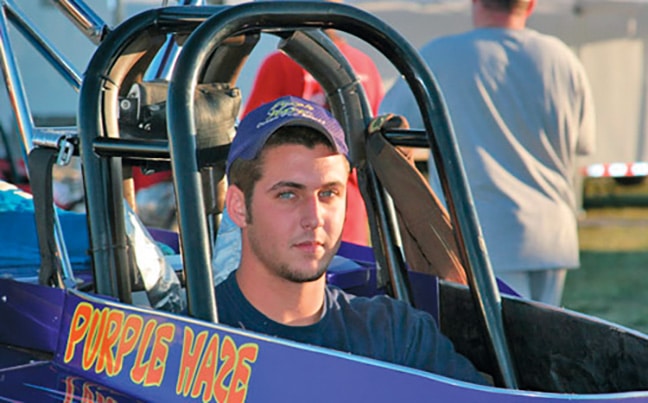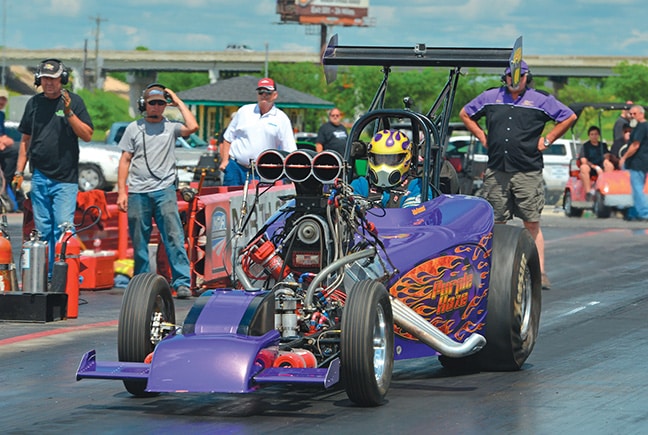For Kevin And John Broussard, Fuel-Altered Racing Runs In The Family
By Kerri Cooke
Featured Photo by Russell Brown

Inspired by what he’d witnessed, he began racing while he was still in high school. His first car was a 1966 Chevy 2 that he used for about two years.
A few years later, in 1980, Broussard created his first altered car, Crazy Horse. He eventually ran it on an alcohol injection.
Later, he got a sponsorship from Gattis in 1984 with a Dodge Daytona, which he sold in 1988. Then he bought 1984 Al Swindall ex. Top Fuel Car, but sold it in 1991. This was the beginning of a 14-year hiatus.
To understand the type of drag racing Broussard is involved in requires an understanding of what car altering means. Altering cars for races can involve a wide variety of changes. A racer can take a regular car and make it an original one. He can put a bigger motor in the vehicle or move the motor around.
The frame of the car is professionally made to meet the needs of the driver, and the weight of the car is changed to make it much lighter.
The ultimate objective is to make the car as fast as possible.
Broussard belongs to a minority racing division in drag racing known as “fuel altered.” Fuel-altered racing takes place when the cars burn methanol, an alcohol-based fuel, instead of gasoline. This formula creates more power and speed than typical fuel.
Officially, the National Hot Rod Association, or NHRA, doesn’t support this type of racing. It was banned from mainstream racing years ago. Now these races are put on by privately owned companies.
The reason the sport was banned was that fuel-altered racing is very dangerous. It’s a very fast race and can be very unpredictable. The cars are hard to control, which can lead to serious accidents.
Despite the risks, fuel-altered racing has appeal for some because it creates the fastest type of drag racing. The power and performance of the cars gives an adrenaline rush like nothing else can. The noise of burning the tires and going from zero to 220 miles per hour in a quarter mile has a huge appeal for car fans.

Another contrast is that the race is over in a very short amount of time.
Also, the noise of these cars can’t be compared with their powerful engines and speed-inducing fuel. They blast down the track in the blink of an eye.
After years of absence from racing, Broussard decided to jump back into the game in 2005. He’d been out of the sport for 14 years. But one day, he went to a race that revived his career. On this day, he found himself at a race in Dallas. The competition was put on by the Painless Performance Outlaw Fuel Altered Assoc., or the OFAA, which Broussard quickly joined after the race.
Almost immediately he set to work building a new race car. Purple Haze is the name of the car that came out of his excitement to get back into the competition. He had it painted purple, with orange and red flames flaring on the side — a design based on another car he’d seen while working on his.

Another influence on the name of the car was the name of the Jimmy Hendrix song “Purple Haze.” For some, that song and its time brings back the memory of the old glory of drag racing. Broussard’s use of the name is a nostalgic tribute to an era.
After the car was completed, Broussard was free to race with the OFAA. The OFAA is beginning its 19th year. It’s the longest ongoing autonomous racing sequence in the southwestern United States. It has about 25 members, and puts on eight races a year.
The ongoing success of the association is attributed to the dedicated racers and the family-friendly atmosphere of the racing events.
Broussard has been involved with the association for the past 10 years. He ventures all over the country, from Dallas, Texas, to Des Moines, Iowa. However, he gave up sitting in the driver’s seat in 2007 when his son, John Broussard, took over the driving of the race car at the age of 18. Broussard now supports his son as the car owner and crew chief.
All those years of racing and being an avid fan eventually paid off in 2014 when Broussard and John won the OFAA championship. This father and son duo found the right combination of luck, hard work and skill to bring home the win. The middle of the season found them second from the top of the bracket.
They were up against some stiff competition, though. Jimmy Jones, who dominated the track, was their biggest competitor. He’d won the previous year and three years before that.
The stakes were highest at the last race. Broussard and John were only one point behind Jones. They gave it all they had, and ended up winning by 10 points. The win was even more special because John, at age 25, became the youngest ever to win a championship.
When Broussard’s son won the championship, it was a fulfillment of all the hard work the two had put in over the years. Kevin Broussard believes it was an honor to win such a challenging competition against retired professional racers who have an unlimited expense account for the best equipment.
Kevin says success in sports is 75 percent luck. Anything can happen in a race that’s so unpredictable. The other 25 percent, he feels, has to do with skill and equipment. Other big factors are a good and supportive team, consistency in competition and a skilled driver; without these, no driver would stand a chance.
In addition to winning the championship in 2014, Broussard also won Crew Chief of the Year, an award he held for the year 2008 as well. This award fully conveys the importance of good leadership to the health of a team.
Another event Broussard has been involved in that is not associated with the OFAA is the Fuel-Altered World Finals that is held in Des Moines, Iowa, annually. Attendance is by invitation only. Fifteen of the top fuel-altered teams in the country are invited. People come from the west and east coasts as well as Canada to race and watch this annual event.
Broussard and his team were runner-up in 2011 an 2012. They haven’t attended recently due to lack of time.
Broussard’s story shows the evolution of a dream. He found what he loved to do at a young age, and decided to follow his interest. Now he can look back over all the years with satisfaction and fond memories that will last forever. But the dream isn’t over yet, as he looks forward to many more years of races and wins.
















Comments are closed.